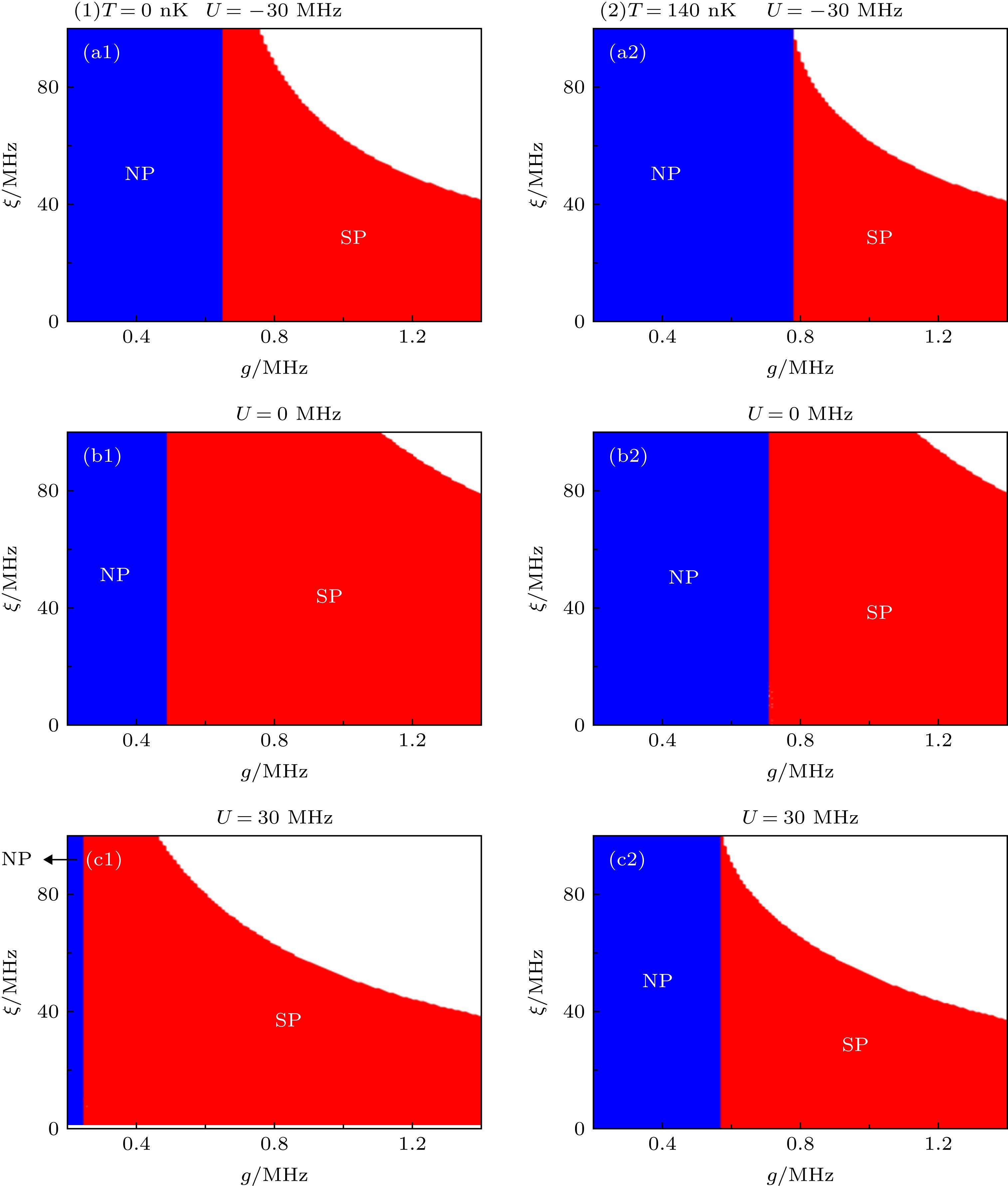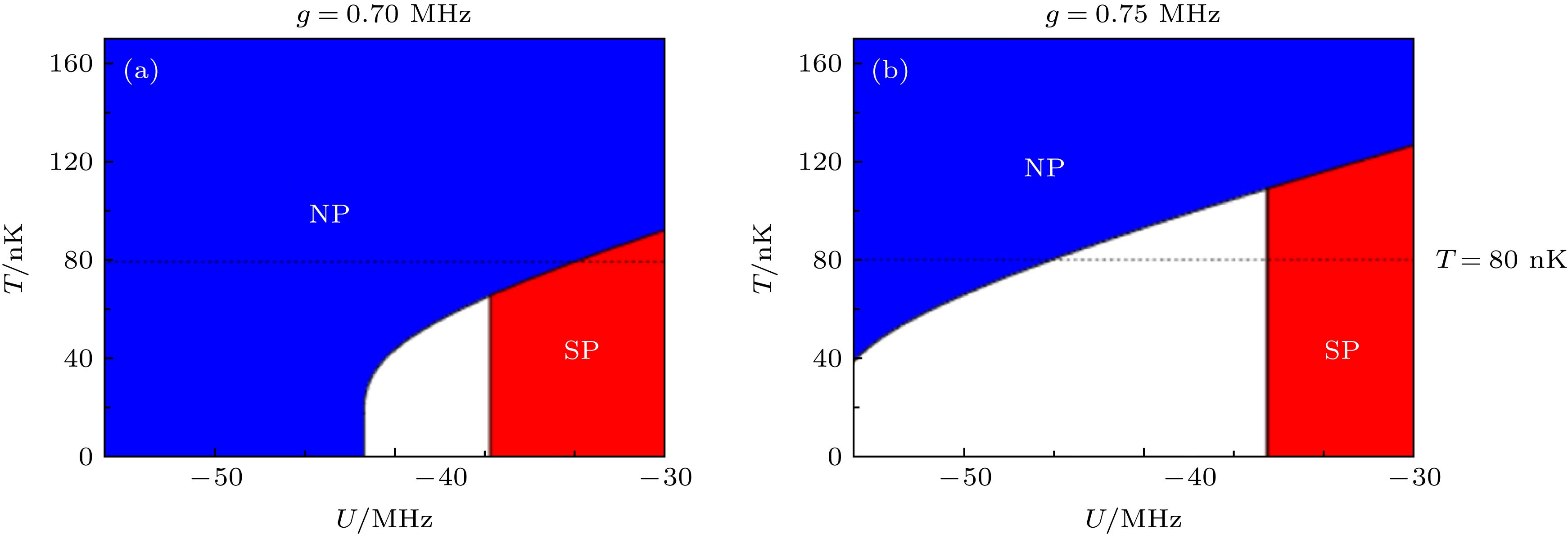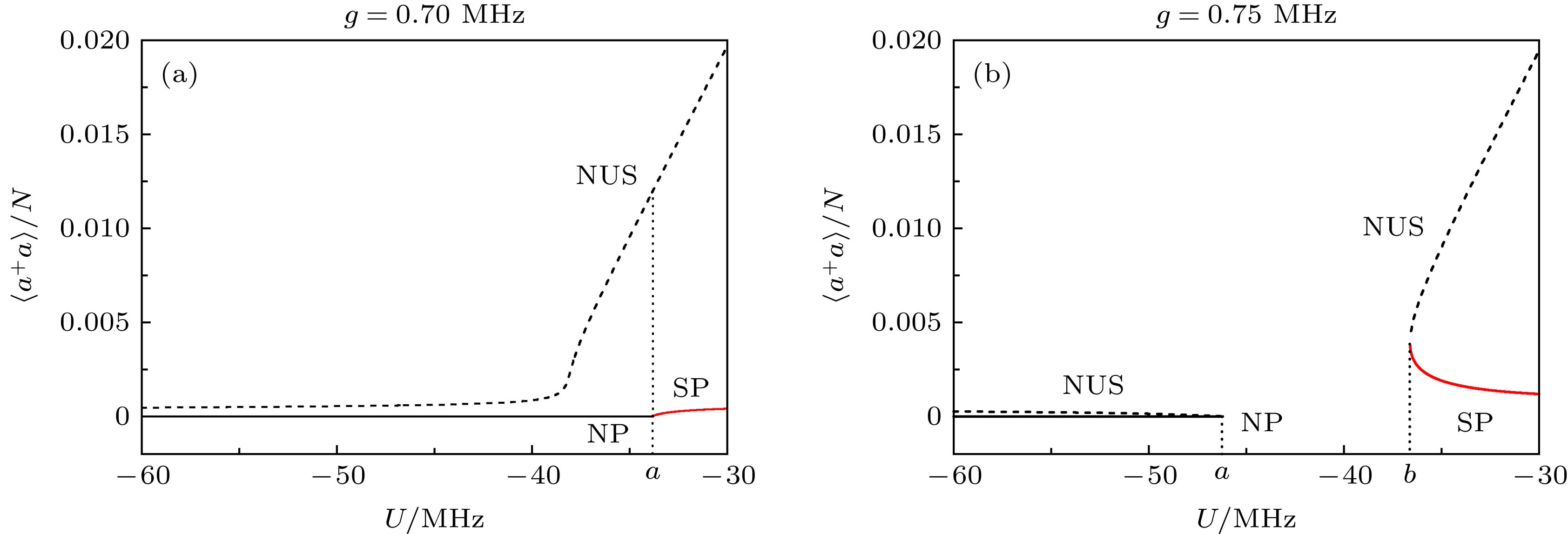-
研究了含有非线性相互作用的腔机械系统中N个二能级原子在有限温度下的相变和相关的热力学性质, 采用虚时路径积分方法推导出系统的配分函数,求得系统的有效作用量. 通过对有效作用量进行变分得到系统的热力学平衡方程和原子布居数期待值的解析表达式, 重点研究了原子-场耦合强度、非线性原子-光相互作用、非线性声子-光子相互作用等影响下系统的相变, 发现除了会发生由正常相到超辐射相的二阶相变外, 还会出现正常相和亚稳的超辐射态共存的现象,同时会发现三相(正常相、超辐射相、亚稳的超辐射态)共存点. 有限温度的升高, 会使正常相到超辐射相的二阶相变点向原子-场耦合强度增大的方向移动; 当非线性原子-光相互作用(正或负)增强时, 相变点会向原子-场耦合强度弱的方向移动; 声子-光子相互作用会导致出现超辐射不稳定态; 有限温度下, 在正常相区熵为定值, 而在超辐射相区熵随原子-场耦合强度的增强迅速递减为零.
-
关键词:
- 有限温度 /
- 相变 /
- 虚时路径积分 /
- 非线性声子-光子相互作用
Optomechanical cavity is a powerful connection between a nanomechanical oscillator and a quantized electromagnetic field. In this system, a novel photon-phonon nonlinear interaction arising from the nanomechanical oscillation is produced through the radiation pressure. Now this nonlinear photon-phonon interaction has become an important resource for implementing high-precision measurements and processing quantum information. Motivated by T. Esslinger group’s experiment, it is very meaningful to explore the exotic quantum phenomena when a ultra-cold BEC is trapped in an optomechanical cavity. In this paper, we mainly investigate phase transition and the finite-temperature thermodynamic properties of a Bose-Einstein condensate in an optomechanical cavity. It’s worth mentioning that at zero temperature many different mean-field approximate methods have been used to analyze the ground state properties of a Bose-Einstein condensate in an optomechanical cavity. Two common methods are Holstein-Primakoff transformation and spin coherent state variation. In this paper, an interesting imaginary-time path integral approach has been introduced to study finite temperature thermodynamic properties and phase transition of a Bose-Einstein condensate in an optomechanical cavity. First, we obtained system's partition function by taking imaginary-time path integration. Meanwhile, an effective action has been obtained by means of this method, which is the basic of the variation to get the numerical solution of photon number and the expression of the atomic number. At zero temperature, these results are consistent with what we have obtained by Holstein-Primakoff transformation or spin coherent state variational method. By adjusting the atom-field coupling strength and other parameters the second-order phase transition from the normal phase to the superradiant phase has been revealed. Meanwhile, a new unstable superradiant state was also found. And we found that in addition to the normal phase and superradiation phase, there exists an un-solution region of the mean photon number. Meanwhile, we find that the nonlinear photon-phonon interaction does not affect the normal phase. However, in the superradiant phase, the nonlinear photon-phonon interaction can enhance the macroscopic collective excitations. At the same time, the thermodynamic properties of the system are also discussed. According to the obtained distribution function, we can derive the analytical expression of the average energy and the free energy. Furthermore, the expression of entropy at finite temperature can also be obtained. we find the nonlinear photon-phonon interaction does not affect the average energy in the normal phase, but the average energy in the superradiant phase can deeply deviate in the large nonlinear photon-phonon interaction. It’s worth mentioning that the mean photon number and average energy in the finite-temperature tend to be consistent with the case in absolute zero temperature in the strong coupling region, while the entropy in the superradiant phase is rapidly reduced to zero as the atom-field coupling strength increases. In other words, strongly coupled collective excited states are highly ordered and are not affected by thermal fluctuations in the temperature range we are considering. The thermodynamic properties, such as the entropy and corresponding specific heat, characterize the Dicke phase transition.-
Keywords:
- quantum phase transition /
- imaginary-time path integral /
- superradiant phase /
- nonlinear photon-phonon interaction
[1] Braginsky V B, Vorontsov Y I, Thorne K S 1980 Science 209 547
 Google Scholar
Google Scholar
[2] Liu N, Li J D, Liang J Q 2013 Phys. Rev. A 87 53623
 Google Scholar
Google Scholar
[3] 陈雪, 刘晓威, 袁春华, 张卫平 2015 64 164211
 Google Scholar
Google Scholar
Chen X, Liu X W, Zhang K Y, Yuan C H, Zhang W P 2015 Acta Phys. Sin. 64 164211
 Google Scholar
Google Scholar
[4] Aspelmeyer M, Kippenberg T J, Marquardt F 2013 Rev. Mod. Phys. 86 1391
[5] Mancini S, Tombesi P 1994 Phys. Rev. A 49 4055
 Google Scholar
Google Scholar
[6] Arcizet O, Cohadon P F, Briant T, Pinard M, Heidmann A, Mackowski J M, Michel C, Pinard L, Francais O, Rousseau L 2006 Phys. Rev. Lett. 97 133601
 Google Scholar
Google Scholar
[7] Dorsel A, McCullen J D, Meystre P, Vignes E, Walther H 1983 Phys. Rev. Lett. 51 1550
 Google Scholar
Google Scholar
[8] Baumann K, Guerlin C, Brennecke F, Esslinger T 2010 Nature 464 1301
 Google Scholar
Google Scholar
[9] Ritsch H, Domokos P, Brennecke F, Esslinger T 2013 Rev. Mod. Phys. 85 553
 Google Scholar
Google Scholar
[10] Padhi B, Ghosh S 2013 Phys. Rev. Lett. 111 043603
 Google Scholar
Google Scholar
[11] Sondhi S L, Girvin S M, Carini J P, Shahar D 1997 Rev. Mod. Phys. 69 315
 Google Scholar
Google Scholar
[12] 黄珊, 刘妮, 梁九卿 2018 67 183701
 Google Scholar
Google Scholar
Huang S, Liu N, Liang J Q 2018 Acta Phys. Sin. 67 183701
 Google Scholar
Google Scholar
[13] Emary C, Brandes T 2003 Phys. Rev. E 67 066203
 Google Scholar
Google Scholar
[14] Popov V N, Fedotov S A 1982 Theor. Math. Phys. 51 363
 Google Scholar
Google Scholar
[15] Lian J L, Liu N, Liang J Q, Chen G, Jia S T 2013 Phys. Rev. A 88 043820
 Google Scholar
Google Scholar
[16] Sun Q, Hu X H, Liu W M, Xie X C, Ji A C 2011 Phys. Rev. A 84 023822
 Google Scholar
Google Scholar
[17] Sun Q, Hu X H, Ji A C, Liu W M 2011 Phys. Rev. A 83 043606
 Google Scholar
Google Scholar
[18] Wang Z M, Lian J L, Liang J Q, Yu Y, Liu W M 2016 Phys. Rev. A 93 033630
 Google Scholar
Google Scholar
[19] Nagy D, Kónya G, Szirmai G, Domokos P 2010 Phys. Rev. Lett. 104 1041
[20] Wang Y K, Hioe F T 1973 Phys. Rev. A 7 831
 Google Scholar
Google Scholar
[21] Hioe F T 1973 Phys. Rev. A 8 1440
 Google Scholar
Google Scholar
[22] Santos J P, Furuya K, Semião F L 2010 Phys. Rev. A 82 063801
 Google Scholar
Google Scholar
[23] Gröblacher S, Hammerer K, Vanner M R, Aspelmeyer M 2009 Nature 460 724
 Google Scholar
Google Scholar
[24] Liu Y C, Xiao Y F, Luan X, Gong Q, Wong C W 2015 Phys. Rev. A 91 033818
 Google Scholar
Google Scholar
[25] Zhang Y W, Lian J L, Liang J Q, Chen G, Zhang C, Jia S T 2012 Phys. Rev. A 87 811
[26] Popov V N 1981 Zap. Nauchn. Sem. LOMI 101 128
-
图 3 原子-光场非线性相互作用影响下, 平均光子数随原子-场集体耦合强度和温度变化的相图
$(g - T)$ , 其中声子-光子耦合强度$\xi \;=\;0\left( {{\rm{MHz}}} \right)$ Fig. 3. The average photon number’s phase diagram of the atom-field collective coupling strength and the temperature for different atom-light nonlinear interaction strength with the disappeared phonon-photon coupling constant
$\xi \;=\;0\left( {{\rm{MHz}}} \right)$ .图 4 原子-光非线性相互作用影响下, 平均光子数关于原子-场耦合强度和声子-光子非线性相互作用强度
$(g - \xi )$ 的相图, 其中有限温度分别为$T\;=\;0\left( {{\rm{nK}}} \right)$ (1)和$T\;=\;140\left( {{\rm{nK}}} \right)$ (2)Fig. 4. The phase diagram about the average photon number of atom-field collective coupling strength and the nonlinear photon-phonon interaction for different atoms-light nonlinear interaction strength with different finite temperature
$T\;=\;0\left( {{\rm{nK}}} \right)$ (1) and$T=140\left( {{\rm{nK}}} \right)$ (2).图 5 在不同的原子-场集体耦合强度下, 平均光子数关于原子-光非线性相互作用和温度(
$U - T$ )的相图, 其中声子-光子非线性相互作用$\xi = 50\left( {{\rm{MHz}}} \right)$ Fig. 5. The phase diagram about the average photon number of the atoms-light nonlinear interaction and temperature for different atoms-field collective coupling strength, where the nonlinear photon-phonon interaction
$\xi = 50\left( {{\rm{MHz}}} \right)$ .图 6 平均光子数
$\left\langle {{a^\dagger }a} \right\rangle /N$ 随原子-光非线性相互作用$U$ 变化的示意图, 给定的参数是: 原子-场耦合强度. (a)$g = 0.7\left( {{\rm{MHz}}} \right)$ 和(b)$g = 0.75\left( {{\rm{MHz}}} \right)$ , 温度$T = 80\left( {{\rm{nK}}} \right)$ 和光子-声子非线性耦合强度$\xi = 50\left( {{\rm{MHz}}} \right)$ Fig. 6. Variations of the average photon number
$\left\langle {{a^\dagger }a} \right\rangle /N$ with respect to the atom-light nonlinear interaction$U$ . The given parameters are the atom-field coupling strength (a)$g = 0.7\left( {{\rm{MHz}}} \right)$ and (b)$g = 0.75\left( {{\rm{MHz}}} \right)$ , the temperature$T = 80\left( {{\rm{nK}}} \right)$ and the photon-phonon nonlinear coupling strength$\xi = 50\left( {{\rm{MHz}}} \right)$ . -
[1] Braginsky V B, Vorontsov Y I, Thorne K S 1980 Science 209 547
 Google Scholar
Google Scholar
[2] Liu N, Li J D, Liang J Q 2013 Phys. Rev. A 87 53623
 Google Scholar
Google Scholar
[3] 陈雪, 刘晓威, 袁春华, 张卫平 2015 64 164211
 Google Scholar
Google Scholar
Chen X, Liu X W, Zhang K Y, Yuan C H, Zhang W P 2015 Acta Phys. Sin. 64 164211
 Google Scholar
Google Scholar
[4] Aspelmeyer M, Kippenberg T J, Marquardt F 2013 Rev. Mod. Phys. 86 1391
[5] Mancini S, Tombesi P 1994 Phys. Rev. A 49 4055
 Google Scholar
Google Scholar
[6] Arcizet O, Cohadon P F, Briant T, Pinard M, Heidmann A, Mackowski J M, Michel C, Pinard L, Francais O, Rousseau L 2006 Phys. Rev. Lett. 97 133601
 Google Scholar
Google Scholar
[7] Dorsel A, McCullen J D, Meystre P, Vignes E, Walther H 1983 Phys. Rev. Lett. 51 1550
 Google Scholar
Google Scholar
[8] Baumann K, Guerlin C, Brennecke F, Esslinger T 2010 Nature 464 1301
 Google Scholar
Google Scholar
[9] Ritsch H, Domokos P, Brennecke F, Esslinger T 2013 Rev. Mod. Phys. 85 553
 Google Scholar
Google Scholar
[10] Padhi B, Ghosh S 2013 Phys. Rev. Lett. 111 043603
 Google Scholar
Google Scholar
[11] Sondhi S L, Girvin S M, Carini J P, Shahar D 1997 Rev. Mod. Phys. 69 315
 Google Scholar
Google Scholar
[12] 黄珊, 刘妮, 梁九卿 2018 67 183701
 Google Scholar
Google Scholar
Huang S, Liu N, Liang J Q 2018 Acta Phys. Sin. 67 183701
 Google Scholar
Google Scholar
[13] Emary C, Brandes T 2003 Phys. Rev. E 67 066203
 Google Scholar
Google Scholar
[14] Popov V N, Fedotov S A 1982 Theor. Math. Phys. 51 363
 Google Scholar
Google Scholar
[15] Lian J L, Liu N, Liang J Q, Chen G, Jia S T 2013 Phys. Rev. A 88 043820
 Google Scholar
Google Scholar
[16] Sun Q, Hu X H, Liu W M, Xie X C, Ji A C 2011 Phys. Rev. A 84 023822
 Google Scholar
Google Scholar
[17] Sun Q, Hu X H, Ji A C, Liu W M 2011 Phys. Rev. A 83 043606
 Google Scholar
Google Scholar
[18] Wang Z M, Lian J L, Liang J Q, Yu Y, Liu W M 2016 Phys. Rev. A 93 033630
 Google Scholar
Google Scholar
[19] Nagy D, Kónya G, Szirmai G, Domokos P 2010 Phys. Rev. Lett. 104 1041
[20] Wang Y K, Hioe F T 1973 Phys. Rev. A 7 831
 Google Scholar
Google Scholar
[21] Hioe F T 1973 Phys. Rev. A 8 1440
 Google Scholar
Google Scholar
[22] Santos J P, Furuya K, Semião F L 2010 Phys. Rev. A 82 063801
 Google Scholar
Google Scholar
[23] Gröblacher S, Hammerer K, Vanner M R, Aspelmeyer M 2009 Nature 460 724
 Google Scholar
Google Scholar
[24] Liu Y C, Xiao Y F, Luan X, Gong Q, Wong C W 2015 Phys. Rev. A 91 033818
 Google Scholar
Google Scholar
[25] Zhang Y W, Lian J L, Liang J Q, Chen G, Zhang C, Jia S T 2012 Phys. Rev. A 87 811
[26] Popov V N 1981 Zap. Nauchn. Sem. LOMI 101 128
计量
- 文章访问数: 12600
- PDF下载量: 91
- 被引次数: 0














 下载:
下载:









































